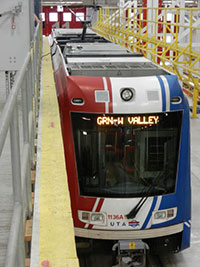
Mobile sample collection via urban transit is gathering critical data on air pollution in the Salt Lake valley.
A group of U of U researchers have collaborated on a project to better quantify the concentrations of greenhouse gases and pollutants that hover, in varying concentrations, over the valley. The researchers—from the Land-Atmosphere Interactions Research (LAIR) group and the Mountain Meteorology group, both part of the University of Utah Department of Atmospheric Sciences— mounted air quality and greenhouse gas monitoring equipment under the driver’s seat on a red line UTA TRAX train, which gathered data as the train moved back and forth from the U to its southern terminus at Daybreak. The pilot ran from Aug. 11-Sept. 12, 2014.
That data proved so useful that the project was recently expanded and retooled to focus on the dangerous pollutants that are trapped in the winter inversion. Data from both the pilot project and the current project are available online.
Dr. Logan Mitchell, who has spearheaded the effort, says the red line is ideal for studying the spatial distribution of greenhouse gases and air pollutants. This is because it covers a large section of the valley, from north to south and east to west, and because it hits multiple elevations, traveling from the nearly-identical higher elevations at both ends of the route through the lower valley bottom in the middle. “If someone had asked me to design a public transit line that is also ideal for atmospheric sampling, I would have designed the red line,” he says.
The monitoring equipment isn’t new; it’s the mounting of it on a moving platform that is innovative, notes Mitchell. He adds that this is the first train-mounted air quality monitoring system employed in the United States. “The UTA has been incredibly helpful and generous with their time—they have really facilitated this project,” he says.
Read more here.

